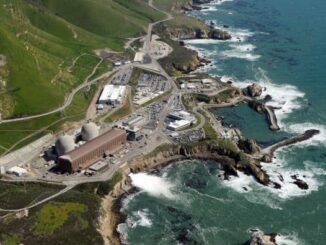
Ever get hooked on a YouTube spiral, where you start off watching one thing purposefully and by choice, then get hooked by the sequence of algorithmic suggestions, the ones that cleverly blend your interests with whatever Google wants to shove down your throat? And then you realize that the sun has set and three hours have passed?
The same thing happens to me when wandering in the weird world of energy. The business used to be somewhat straightforward and tethered to reality, but now it’s tentacles end in crazy town. It’s like starting to watch a YouTube piece about how to replace an air furnace filter and fifteen minutes later you’re watching Weird Al Yankovic.
In the energy news the other day was a headline about how “California Utility PG&E requested approval for a 387 MW/1,584 MWh of battery storage procurements.” Batteries in the electrical system are quite fascinating. They can have great value (and profitability) when used to provide power for short bursts when power prices spike (as often happens), however the next-level concept of batteries + wind + solar as a replacement for hydrocarbon or nuclear sources has somehow caught on in the public imagination.
The latter is too stupid for words, yet advocates point to it as some sort of solution through sheer ignorance of how batteries work, discharge, and recharge under severe load conditions (when they are needed most).
That’s why the headline was so interesting. Was PG&E ‘requesting approval’ for battery storage as a means to solve California’s energy shortages? My piqued curiosity then led me down a weird rabbit hole much like an unexpected YouTube odyssey.
Ultimately, I followed the trail of PG&E’s actions to a CPUC (California Public Utilities Commission) regulatory ruling. The original story noted above touched on some aspects, but the real juicy story came out of the long, belaboured regulatory document (I a well aware of how sad it is to call that a juicy story, you don’t need to point it out).
The PG&E battery article eventually explained the rationale for the battery installation – CPUC ordered PG&E to install them. The headline made it sound like PG&E was aching to do it; turns out they would be aching if they didn’t do it.
CPUC’s order, according to the article, was initiated because of an anticipated shortage of power over the next few years (“The utility had been ordered by the CPUC to procure at least 716.9MW of system reliability resources to pre-emptively solve expected electric system reliability issues in California that will result from the retirement of several large-scale fossil fuel generation assets…”).
Nothing too peculiar about that; it is just CPUC putting in place an admittedly odd measure to try to ensure adequate power supplies (what makes it weird is…why batteries? And why close fossil-fuel generation assets just to order new less reliable ones to be built?).
That’s where the story gets interesting, in the CPUC ruling itself. First, some background. CPUC’s marching orders apparently come about in two ways, more or less. One is legislative; California has ordered the state’s power to become more renewable. The second major factor in CPUC’s output is the staffing of their board. California’s governor appoints all five members, and they are about what you’d expect fro him.
Two can quite easily be described as environmental activists (inclusion of the words ‘environmental justice’ and ‘environmental equity’ in their bios is good enough for me), two are career public servants with extensive renewable advocacy backgrounds, and one is a public administration lifer, but is an engineer and does appear to have a decent smattering of actual energy system knowledge (not experience, but knowledge, based on participation in some formal proceedings concerning the industry, anyway).
CPUC is caught in a tight space. The orchestrated if illogical hatred for hydrocarbons is in full swing; a significant number of gas-fired power had been ordered shut by Dec 31, 2020. (The hatred also extends to nuclear, with the Diablo Canyon facility being fast-tracked to the dumpster long before it is ready.)
At the same time, CPUC is scratching its head as it ponders snips of reality: “California’s system peak is moving later in the day and later in the year, which does not coincide with the value provided by solar resources, though they have been the resource of choice to date…” They are indeed the resource of choice when the government forces the industry to the front of the class.
Furthermore, CPUC acknowledges the state’s increasing reliance on power imported from other states, noting nervously that “Imported capacity for California may become scarcer in the future…Hydroelectric capacity, especially from the Northwest imported into California, is becoming in higher demand, in part due to the renewable policies of other states in the West.” They don’t want to hear about imports of hydrocarbon power; the activists don’t like that (more in a second).
You can see the noose starting to tighten here. But it gets much worse. The ruling began the prior year by “seeking comment from parties on policy issues related to reliability.” Comments were received from 44 parties – about a dozen actual power companies, a handful of consumer power associations, ten wind/solar associations/companies and two really interesting other categories.
One was climate activist groups like the Sierra Club and National Resources Defence Council – in total there were eight of these. The other really interesting party was – CAISO, the California Independent Systems Operator, which “manages the flow of electricity on high-voltage power lines, operates a wholesale energy market, and oversees infrastructure planning.”
Reading through the document, it is stunning to see CAISO treated no differently than any of the climate activist groups. Think about that for a second. The system operator is waving a red flag about potential power shortages, and CPUC’s activist board gives an equal ear to the likes of the Sierra Club with respect to planning. You can imagine how helpful Sierra Club’s input is.
What sort of a red flag did CAISO raise? How about this: “CAISO states that without action, there will be system resource adequacy capacity shortfall in 2021…in addition to a resource adequacy capacity shortfall, there could be an “operational” capacity shortfall of closer to 4,400 MW by 2021.” Southern California Edison, the state’s largest power company, backed up CAISO, stating that “the system resource adequacy reliability shortfall in 2021 could be as much as 5,500 MW, continuing over the next several years after that.”
On top of this, the system operator is waving an even bigger red flag about relying on imported power: “Easily the party expressing the most concern about increased reliance on imported power is the CAISO DMM.” That isn’t related to the capacity shortfall noted earlier; it is uncertainty in addition to it.
And how idiotic were the requests of the Sierra Club and Union of Concerned Scientists? These (among others) demanded that all hydrocarbon power plants scheduled to be shut down by the end of 2020 be shut down by that date. These groups had no suggestions on how to solve the issue, just that reliance on natural gas was unacceptable. Several of them went after power imports, insisting that power only be allowed into the state if it was being replaced by renewable in the exporting state.
The insanity of this last one is off the charts; California would be importing power when their own renewables were unable to meet the challenge, so blocking imports on any grounds is as sure a predictor of power outages as you can get.
But they don’t care. Hydrocarbons must die, the zombies repeat, ad nauseum.
In a very small victory for Californians, CPUC rejected one demand, and allowed a handful of gas-fired power plants to remain in service for 1-3 more years (actually they made the request for the water authorities to allow them to stay open). But CPUC showed it’s activists roots, taking activist organizations demands for fuel sourcing as sound advice (“Like most parties, we support solicitations being conducted in an all-source manner, allowing all types of resources to count toward the 3,300 MW requirements…However, we will adopt the prohibition on new fossil-fueled resources suggested by CEJA, Sierra Club, and DOW in their comments.”)
CPUC’s attitude borders on the bizarre. Their responsibility is to ensure that residents have power (continuous power, I am assuming). Yet they seem almost flippant about it; reliability is great but no-fossil-fuels is the drop-dead certainty. The ruling uses the phrase ‘least regrets’ no fewer than eight times (as in, ‘…we view the requirement for additional procurement now as a“least regrets” strategy, since electricity shortages would most certainly lead to regrets…For reasons articulated by many parties, the severity of this reliability challenge is uncertain..’)
In the end, CPUC ordered each market participant to install new power capacity totalling 3,300 MW. The amount is far short of what the largest power company and the system operator wanted; CPUC sided with the activists in not allowing any fossil-fuelled power to fill the gap.
Thus we saw PG&E ‘request approval’ for new battery installations. They had no choice. (Geothermal was noted as an acceptable option, but there clearly are hurdles launching that in a few short years. Or they would have done so.)
Think about this for a second. Power providers are being forced to add battery storage with a maximum of 4 hours of reserve, which is not comparable in any sense with the baseload capability of natural gas or nuclear. The system operator has said that this is not enough, because batteries last only a few hours and cannot be counted on for extended periods (as in, any time longer than a few movies).
On top of that, the system operator (and even CPUC itself) acknowledges that relying on import power is not a very good strategy, particularly a year or two out, because other jurisdictions might need it at the same time. On top of even that, the state remains committed to shutting down a critical nuclear plant early, one which provides nearly ten percent of the state’s baseload power. (In a separate CAISO study about how to make solar power more useful to the grid, the system operator makes these comments (in 2017!): “High levels of solar generation during mid-day hours are already contributing to oversupply…The CAISO currently has over 9,000 MW of transmission connected solar resources… the CAISO is expecting an additional 4,000 to 5,000 MW of solar. Beyond 2020, to meet a 50% RPS, the CAISO is expecting an additional 15,000 MW of renewable resources… a significant portion of this is anticipated to be transmission connected solar.”
By edict, the system is outrageously oversupplied in the middle of the day and starved for the other 18 hours – and the race is on to add more solar. You can’t make this s**t up.)
It was frightening to read CPUC’s neuron-free decision process; listening to the system operator and climate activists, then siding with activists. That’s right – they listen to the Sierra Club more than they listen to the non-partisan organization that “manages the flow of electricity on high-voltage power lines, operates a wholesale energy market, and oversees infrastructure planning.”
And the activists were silent whenever the call for sensible options was offered; they reserved their comments only for the purpose of sabotaging anything they don’t like.
In 2020, CPUC added $830 million to a program to help citizens arm themselves with “battery storage systems that can function during a power outage.” They know what’s coming. They would rather subject the state’s population to power outages than add clean-burning natural gas.
California’s next power outages will be a direct result of not climate change, but climate change activists. That conclusion is inescapable.
This ain’t a movie. But it is movie-like; apparently bodies must be stacked quite high before this grip of insanity can be shaken.



